

13 Alternatives to Traditional Testing. Please note: While our site is undergoing its upgrade and redesign, all essential resources to support your teaching can be found on this site, and many of the pedagogical materials from our previous site are still available through the main and sub-menus above.

If something is missing, please let us know. Intended to be “a space to dream big about teaching,” the Teaching Commons supports faculty, instructors, and graduate students in developing and applying innovative and research-based approaches to all areas of teaching and learning: Instructional designCurriculum developmentClassroom managementEducational technologyActive learningExperiential educationIndigenous curriculum integrationAnd much, much more! We also curate essential pedagogical resources on these and other teaching-related topics and provide technical support for mycourselink/D2L. Call (807.343.8010 ext. 7730), email (teachingcommons@lakeheadu.ca), or stop by (LI 5014; after the pandemic!) Assessment For, As, and Of Learning. Difference Between Assessment and Evaluation. Difference Between Formative and Summative Assessment.
Assessment in Online Learning. Quizzes. E-Portfolios. Rubrics. Feedback. Assessment for Learning at King's – Assessment and Feedback Strategies recommended by King's Academy. Welcome to Assessment for Learning at King’s.
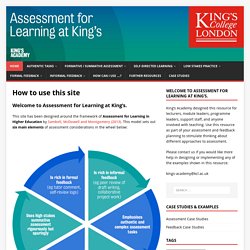
This site has been designed around the framework of Assessment for Learning in Higher Education by Sambell, McDowell and Montgomery (2013). This model sets out six main elements of assessment considerations in the wheel below: Each element above is reflected in the navigation links of this site: Each area contains: an explanation of the key principle/aspect of AfL,a range of assessment and feedback practices,examples of how these have been implemented (from King’s, the UK or international HE sector),key design questions to consider when redesigning assessment practices. These practices can be used in formative or summative situations; this resource has a strong research-informed focus on the benefits of shifting the balance towards formative assessment.
About this site. Bad Assessment – Challenging the Role of Assessment in Higher Education. How To Design Assessments That Promote The Learning Process.
Cheating and Plagiarism. Poster Assignments. Template. Three Ways to Support Online Learners. Trying to support students in an online course can create an unsustainable burden on the instructor.

“I’ve heard faculty members say things such as, ‘When I first started teaching online, I drowned in my course. I was making myself available 24 hours/seven days a week. If a student posted, I felt I had to reply immediately. They were counting on me regardless of time of day,’” says Dr. Laurie Grosik, assistant professor in the master in health science program at Saint Francis University. Rhythm/template “We don’t want students to be baffled by the technology. In addition to having a familiar look and feel, online courses should provide students with regular interaction. 4 Points about Extra Credit. "The Annual Extra-Credit Warning" (post) lists some points to consider if, at the end of a course, a student asks, "Is there anything I can do to improve my grade?

" TL; DR version - "Mercy is admirable, but so is fairness. " 1. "There’s an understandable human impulse to take pity on a penitent soul. " "But if you aren’t careful, a favor done for a sympathetic student can look to another student like discriminatory treatment: 'Why did he get a chance I didn’t get? '""If you don’t have a good answer for that -- one you could defend under oath -- it can get ugly. " 2. "Otherwise, don’t do it at all. "" 3. "There’s a difference. "" 4. "When the professor sticks to their own rules and enforces them evenhandedly, there’s never an issue upholding the grade. "" Authentic Assessment 1: What It Is, When to Use It, Benefits and Challenges. A.
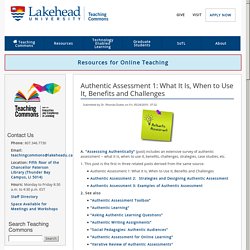
"Assesssing Authentically" (post) includes an extensive survey of authentic assessment -- what it is, when to use it, benefits, challenges, strategies, case studies, etc. 1. This post is the first in three related posts derived from the same source: Authentic Assessment 1: What It Is, When to Use It, Benefits and ChallengesAuthentic Assessment 2: Strategies and Designing Authentic AssessmentAuthentic Assessment 3: Examples of Authentic Assessment 2. Assessments for Learning in Large Classes.
"Assessments that Support Student Learning" (pdf) outlines "[f]actors that make assessment contribute to learning (and are frequently neglected)" as well as ten tips (with practical strategies) for "[i]mplementing good assessment and feedback without spending excessive time marking.
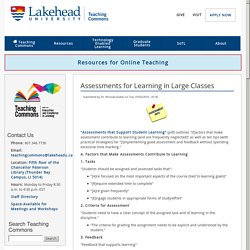
" A. Factors that Make Assessments Contribute to Learning 1. 13 Alternatives to Traditional Testing. A.
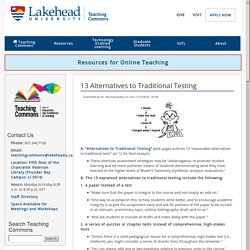
“Alternatives to Traditional Testing” (web page) outlines 13 “reasonable alternatives to traditional tests” (or 12 for final essays!). These alternate assessment strategies may be "advantageous to promote student learning and be more authentic means of students demonstrating what they have learned at the higher levels of Bloom's Taxonomy (synthesis, analysis, evaluation).” B. The 13 explained alternatives to traditional testing include the following: 1. Online Discussion Forums as Assessment Tools - Faculty Focus. Classroom Assessment Techniques, or CATs, are simple ways to evaluate students’ understanding of key concepts before they get to the weekly, unit, or other summative-type assessment (Angelo & Cross, 1993).
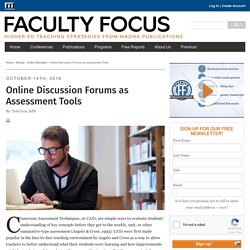
CATs were first made popular in the face-to-face teaching environment by Angelo and Cross as a way to allow teachers to better understand what their students were learning and how improvements might be made in real time during the course of instruction. But the same principle can apply to online teaching as well. Impact and Examples There are many types of CATs that work well in the online classroom. Which Assessment Strategies Do Students Prefer? While most faculty stick with the tried-and-true quiz and paper assessment strategies for their online courses, the wide range of technologies available today offers a variety of assessment options beyond the traditional forms.
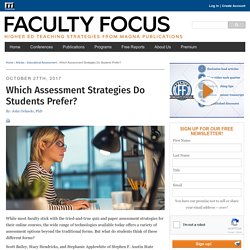
But what do students think of these different forms? Scott Bailey, Stacy Hendricks, and Stephanie Applewhite of Stephen F. Austin State University experimented with different assessment strategies in two online courses in educational leadership, and surveyed students afterward on their impressions of each one. The students were asked to score the strategies using three criteria: 1) enjoyment, 2) engagement with the material, and 3) transferability of knowledge gained to practice. Peer Assessment that Improves Performance in Groups. Peer assessment in groups has been shown to effectively address a number of group process issues, but only if the peer assessment has a formative component.
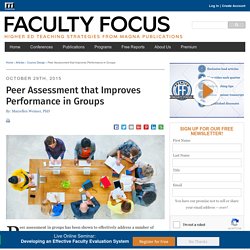
Many studies have shown that if peer assessment is used at the end of a group project, group members will punish their dysfunctional members—those who didn’t do work, didn’t turn work in on time, didn’t come to meetings, and didn’t do quality work—but they won’t confront those group members when they commit those dysfunctional behaviors. After-the-fact peer assessment gives the teacher input on who did and didn’t contribute in the group, but it doesn’t change what happened in that group or help students learn how to confront group member problems when they emerge.
Faculty members Anson and Goodman describe an online peer assessment system they developed that can be administered efficiently, provides quality feedback, and fosters effective team processes. Details for setting up and using the system are laid out in the article. Built-in Self-Assessment: A Case for Annotation. If we want students to be critical thinkers, we must routinely and explicitly give them structured practice opportunities to critically examine their own thinking. Squeezing two or three metacognitive activities into a hectic semester teaches students that such reflection is only for special occasions. Rather, student self-evaluation should be a daily course routine. As an alternative to time-consuming, discrete, self-reflective assignments, we’ve turned to annotation as a built-in flexible routine to bolster any stage of the learning process. Used as a companion to new skills or assignments, annotation helps students see how they are meeting assignment goals, make plans for improvement, and create a narrative of growth.
The results of annotation as a classroom routine are students with self-evaluative habits that reach beyond our courses and assignments. Here are a few of the reasons that annotation as a built-in flexible routine helps shift the ways students think and behave: Assessment Strategies. Teaching and Assessment Strategies. Taking practice-based and literature-informed approaches, the CTL partners with Queen’s educators by providing expertise to enhance pedagogical practices, and provides educational leadership within the context of Canadian higher education. Teaching for Active Learning. Classroom Assessment Strategies.
Classroom Assessment Strategies Assumptions of Classroom Assessment Assumption ONE The quality of student learning is directly, although not exclusively, related to the quality of teaching. Align Assessments, Objectives, Instructional Strategies-Teaching Excellence & Educational Innovation. Assessments should reveal how well students have learned what we want them to learn while instruction ensures that they learn it. For this to occur, assessments, learning objectives, and instructional strategies need to be closely aligned so that they reinforce one another. To ensure that these three components of your course are aligned, ask yourself the following questions: Assessment Strategies. Course Evaluation Methods: 8 tips + 42 methods + 12 links. To create a favourable climate for learning, creature comforts such as good food and accommodation may help.